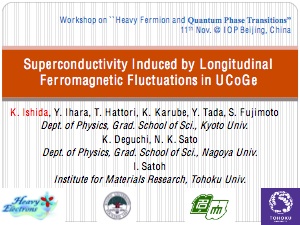Institute of Physics, Chinese Academy of Sciences


Nov 10-12, 2012

Spin-Triplet Superconductivity Induced by
Longitudinal Ferromagnetic Fluctuations in UCoGe
K. Ishida,1 T. Hattori,1 Y. Ihara,1 Y. Nakai,1 Y. Tada,1 S. Fujimoto,1 N. Kawakami,1
E. Ozaki,2 K. Deguchi,2 N. K. Sato,2 and I. Satoh3
1Department of Physics, Graduate School of Science, Kyoto University, Kyoto 606-8502 Japan
2Department of Physics, Graduate School of Science, Nagoya University, Nagoya 464-8602 Japan
3Institute of Materials Research, Tohoku University, Sendai, 980-8577, Japan
We report 59Co nuclear magnetic resonance (NMR) and nuclear quadrupole resonance (NQR) studies on the single crystalline ferromagnetic superconductor UCoGe, which exhibits ferromagnetic ordering at TCurie =2.5 K and superconductivity below TSuper = 0.57 K [1]. The internal magnetic field at the Co site originating from the ferromagnetic moments was detected from the 59Co-NQR measurements [2]. Temperature variation of the 59Co-NQR spectra shows that the NQR signals arising from the paramagnetic (PM) and ferromagnetic (FM) regions coexist between 1 and 2.7 K, but the PM signal was not observed below 0.9 K. This suggests that the FM transition possesses a first-order-like character, and that single-crystal UCoGe is in the homogeneous FM state throughout the sample below 0.9 K.
The nuclear spin-lattice relaxation rate (1/T1) measured at the FM NQR signal decreases below TSuper due to the opening of the superconducting (SC) gap, which gives unambiguous evidence for the microscopic coexistence of ferromagnetism and superconductivity in UCoGe. We also synthesized a reference compound YCoGe without 5f electrons, which possesses the same crystal structure as UCoGe, and investigated its physical properties. Since YCoGe shows neither ferromagnetism nor superconductivity down to 0.5 K, it is thus considered that ferromagnetism and superconductivity observed in UCoGe originate from its U 5f electrons.
In order to investigate the anisotropy of magnetic fluctuations and spin susceptibility from a microscopic view points, we have performed 59Co-NMR measurements. From the analysis of angular dependence of the NMR spectra, we have succeeded in determine the principal axis of electric field gradient at the Co site. This has enabled us to measure 1/T1 and Knight shift for each axis. The experimental results indicate that both static and dynamic susceptibilities are ferromagnetic with strong Ising anisotropy along the c axis [3].
In addition, from the angle-resolved NMR measurements, we found that the magnetic field along the c axis (H//c) strongly suppresses both the FM Ising-type fluctuations and superconductivity in the same way [4]. These results strongly suggest that the characteristic FM fluctuations tuned by H//c induce the unique superconductivity in UCoGe, which is anticipated to be a spin-triplet superconductor.
[1] N. T. Huy et al., Phys. Rev. Lett. 99, 067006 (2007).
[2] T. Ohta et al., J. Phys. Soc .Jpn. 79, 023707 (2010).
[3] Y. Ihara et al., Phys. Rev. Lett. 105, 206403 (2010).
[4] T. Hattori et al. Phys. Rev. Lett. 108, 066403 (2012).

click the picture to download
contact
Yi-feng Yang, Institute of Physics, Chinese Academy of Sciences, P. O. Box 603, Beijing 100190, China. Tel: (86)-10-82649448, (86)-18911600270; Fax: (86)-10-62553698; Email: yifeng@iphy.ac.cn


